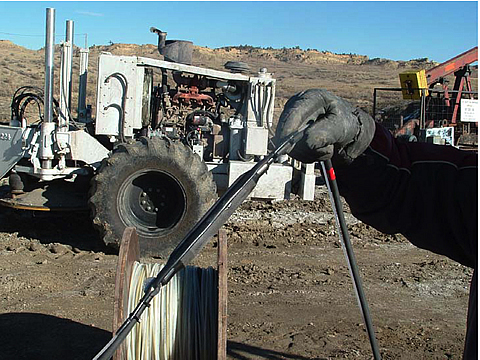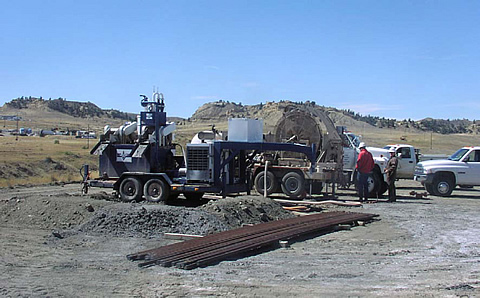The use of production and injection wells for seismic data acquisition has a number of disadvantages. Deploying seismic sensors and other logging-type tools interrupts field operations, resulting in loss of money through temporarily stopped production and idle time for expensive equipment and personnel. Production and injection wells often are not positioned in the most advantageous locations for obtaining reservoir data. Conventional wells dedicated to seismic monitoring are expensive to drill.
Microholes (wellbores less than 3 1/2-inch diameter) have the advantage of being relatively inexpensive to drill, and locations and completion designs can be selected for optimal acquisition of seismic data.
In previous DOE-funded projects, LANL has demonstrated that coiled-tubing microdrilling of wells as small as 1 3/4 inches in diameter and as deep as 800 ft can be achieved. The LANL team also successfully field-tested geophysical micro-instrumentation in microholes cased with 11/4-inch tubing.
Project Results
The acoustic performance of the geologic formations in the CO2 injection area has been modeled and was used to select four well locations for CO2 flood monitoring. Seismic arrays were selected, and the equipment needed to assemble and deploy the arrays was procured.
The first micro-instrumentation CO2-monitoring hole was drilled and completed in October 2004. The 808-ft well was completed with PVC casing set below 587 ft, where intermediate steel casing was cemented to isolate the Shannon formation. The second micro-instrumentation hole was drilled to 407 ft and similarly completed. A multi-offset, vertical seismic profile survey was conducted successfully in one of the 800 ft microholes.
Benefits
The overall objective of this project is to demonstrate the technical and economic feasibility of a highly mobile, self-contained, microhole drilling system as an enabling technology for commercially viable seismic-data acquisition. Succeeding in these objectives will result in reduced access (well) cost and improved quality of data. Air-filled microholes completed with PVC (or other nonmetallic casing) are expected to provide the lowest noise environment possible for retrievable seismic instrumentation.
Project Summary
The motivation to examine microholes for seismic data acquisition comes from providers of geophysical data to the oil and gas industries that seek low-cost access to the subsurface for the emplacement of seismic instrumentation for a variety of purposes: conventional reflection surveys, natural and induced seismicity mapping, vertical seismic profiling, and crosswell imaging are all enhanced with the use of deep seismic sensors. Emplacement of seismic instrumentation in the subsurface results in highly attenuated natural surface- and cultural noise-reduced seismic-signal travel paths through highly attenuating surface layers and a greatly improved signal-to-noise ratio. Conventional wells are usually too costly, and existing wells of opportunity seldom provide the instrumentation sites required at an acceptable cost. Microholes have the advantage of being fit for the purpose of subsurface deployment of instrumentation in the location required at a substantially lower cost.
This project will 1) investigate the feasibility of installing 3/4-inch coiled tubing on the LANL coiled tubing unit to extend microhole depth capability to 1,500 ft, 2) improve the performance of the LANL low-cost, highly portable, micro-sized cement mixing equipment and displacement pumps, 3) demonstrate a low-cost micro-wellhead concept for production, and 4) complete a demonstration microhole production system at RMOTC.






